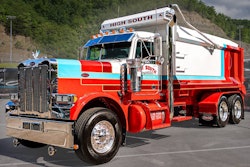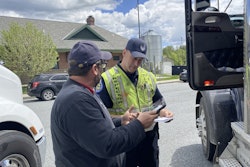Most Carriers Unranked Under CSA
Avery Vise
Barely 12 percent of active motor carriers are ranked in any of the five safety categories within the new Safety Measurement System that the Federal Motor Carrier Safety Administration made public for the first time on Dec. 12, according to an analysis by Commercial Carrier Journal, which is a sister publication of Truckers News.
The SMS, which replaced SafeStat, is a key component of what FMCSA now formally calls Compliance, Safety, Accountability (CSA) — not Comprehensive Safety Analysis 2010. The agency published SMS data and metrics after a federal appeals court turned down an emergency request for a stay.
CCJ’s analysis of data published at FMCSA’s Analysis & Information website shows that only 92,184 of the 758,682 active motor carriers in the agency’s database are ranked in any of the five publicly available Behavior Analysis and Safety Improvement Categories (BASICs) — Unsafe Driving, Fatigued Driving, Driver Fitness, Controlled Substances and Vehicle Maintenance. The Cargo-Related and Crash Indicator BASICs are, for now, withheld from the public due to agency concerns that the data could be misleading.
Of the 92,184 carriers that are ranked in at least one BASIC, 52,967 carriers have at least one alert, meaning they exceeded the threshold for intervention. The greatest number of alerts, 29,207, are in the Fatigued Driving BASIC, followed by the Vehicle Maintenance BASIC at 21,791. The Controlled Substances BASIC had the fewest alerts at 3,605.

The majority of carriers are unranked because FMCSA set minimum thresholds of inspections to be considered within BASIC safety event groups. Those floors vary, but generally carriers must have three to five inspections in the past 24 months to be ranked in a BASIC. FMCSA plans to use those rankings to target interventions under its new graduated process, which starts with warning letters and escalates potentially to full-blown compliance reviews.
FYI News Briefs
Class 8 Truck Orders Increase
November net orders of heavy-duty Class 8 commercial vehicles for North American markets increased 38 percent over October to 26,268 units, according to ACT Research Co. In the latest release of the State of the Industry: Classes 5-8 Vehicles, ACT noted Class 8 net orders rose to the highest monthly total in more than four years.
November Trailer Orders Surge
Net orders of commercial trailers of 21,314 units in November increased 23 percent over October, which was the strongest month in more than two years, ACT Research Co. said. November net orders more than tripled from the same month last year.
November Tonnage Slips Slightly
The American Trucking Associations’ advance seasonally adjusted For-Hire Truck Tonnage Index edged 0.1 percent lower in November after increasing a revised 0.9 percent in October. Compared with November 2009, adjusted tonnage climbed 3.9 percent, which was significantly lower than October’s 6-percent year-over-year increase. Year-to-date, tonnage is up 5.9 percent compared with the same period in 2009.
Truckers Raise $71,000 for Troops
The fourth annual Truckers for Troops campaign by the Owner-Operator Independent Drivers Association raised more than $71,000 going to care packages for military personnel stationed in combat areas overseas. The campaign ran Dec. 6-10, aided by a donation from Shell Rotella for $5,000. OOIDA members and supporters have contributed nearly $230,000 over the four previous campaigns.
Bill Adds Weight Program
A provision has been added to an omnibus government funding bill that would extend the Maine and Vermont truck weight pilot program for one year. The pilot program gives heavier six-axle trucks full access to interstate highways in Maine and Vermont. The Obama administration and Maine DOT both have supported the permanent extension of the pilot program and have credited it with having improved safety and productivity on Maine and Vermont highways.
Kenworth Dealership Moves to I-35
Performance Kenworth has moved its full-service dealership from Austin, Texas, to Buda, Texas, about 15 miles south of its former location. The move will offer customers easier access from Interstate 35, Kenworth says. The dealership’s new location sits on a 6-acre site about a mile southeast of exit 220 on I35, which runs between Dallas and San Antonio.
Speeding Tops Safety Violations
Staff Reports
According to data released from the Commercial Vehicle Safety Alliance’s (CVSA) Operation Safe Driver campaign, the top three reasons warnings and citations were issued to both commercial and non-commercial vehicle drivers include speeding, failing to use a safety belt and failure to obey traffic control devices.
Of the warnings issued to commercial drivers, 20.3 percent were for speeding (versus 61.2 percent for passenger car drivers); 4.2 percent were for failure to obey traffic control devices (compared to 5.8 percent for passenger car drivers); and 2.6 percent were for failing to use a seat belt while operating their vehicle (compared to 2.8 percent for passenger car counterparts).
Citations issued to commercial drivers followed a similar trend, with 13.7 percent for speeding, 4.6 percent for failure to obey traffic control devices and 10 percent for failing to use a seat belt while operating their vehicle. Commercial drivers were issued significantly more warnings and citations in 2010 for failing to buckle up (1,055) versus in 2009 (672).
The fourth annual Operation Safe Driver took place Oct. 17-23, when law enforcement officers nationwide pulled over nearly 53,000 commercial and passenger vehicle drivers. Operation Safe Driver was launched in 2007 by CVSA in partnership with the Federal Motor Carrier Safety Administration to address the problem of improving the behavior of all drivers operating in an unsafe manner and to initiate educational and enforcement strategies to address those exhibiting high-risk behaviors.
“CVSA’s Operation Safe Driver is targeting each and every driver, whether they drive a passenger car or a CMV, and alerting offenders that their poor driving behaviors result in lives lost,” said Stephen A. Keppler, CVSA’s executive director. “We will continue to emphasize this point, through both education and enforcement tactics, until we eliminate those driver behaviors that are specifically linked to causing crashes.”
Agency to Consider Speed Rule in 2012
Avery Vise
More than four years after the trucking industry asked the federal government to mandate speed limiters on new heavy-duty trucks, the National Highway Traffic Safety Administration announced it will launch a rulemaking on the issue in 2012.
In August, senior officials with NHTSA and the Federal Motor Carrier Safety Administration told proponents of speed limiters they anticipated making a formal decision on launching a rulemaking by the end of 2010.
According to a notice that was schedule to be published last month in the Federal Register, NHTSA is granting two separate petitions for rulemaking filed in 2006 — one by the American Trucking Associations and the other by safety advocacy group Road Safe America along with nine trucking companies — Schneider National, C.R. England, H.O. Wolding, ATS Intermodal, Dart Transit, J.B. Hunt, U.S. Xpress, Covenant Transport and Jet Express.
Both petitions proposed installation of devices on new trucks that would limit top speed to 68 mph on trucks with gross vehicle weight ratings (GVWR) greater than 26,000 pounds. The major difference between the petitions is that Road Safe America and its nine carrier allies also want speed limiters mandated on all existing trucks built after 1990.
The Owner-Operator Independent Drivers Association is opposed, however. “Speed limiting a truck at 68 miles per hour, or at any other speed, will not improve highway safety,” said Todd Spencer, executive vice president of OOIDA. “All credible highway research shows that highways are safest when all vehicles travel at the same speed and that different speeds for cars and trucks actually increase the likelihood of accidents.”
A study conducted by the University of Arkansas showed that speed limit differences between trucks and cars increase speed differentials, which create more dangerous interactions between trucks and cars, OOIDA said. Also, a study conducted by the University of Michigan Transportation Research Institute shows that speed limited trucks are overrepresented in rear-end fatalities involving large trucks. Four percent of all trucks are speed limited, yet half of the rear-end fatalities involving trucks were with speed-limited trucks, the association pointed out.
NHTSA’s notice granting the petitions does not explain why it won’t begin the rulemaking for more than a year. The notice does mention, however, that NHTSA expects FMCSA to publish findings of a study on the safety impact and associated economic benefits of speed limiters in commercial motor vehicles.
The decision to grant the petitions from ATA and Road Safe America to conduct a rulemaking does not mean that a final rule will be issued, NHTSA said in its Federal Register notice. “The determination of whether to issue a rule is made after study of the requested action and the various alternatives in the course of the rulemaking proceeding, in accordance with statutory criteria.”
Even if NHTSA doesn’t ultimately adopt the specific rule ATA and Road Safe America seek, speed limiters would become more common under another rule NHTSA and the U.S. Environmental Protection Agency already propose related to heavy-truck fuel efficiency and greenhouse gas emissions reduction. Under the EPA/NHTSA proposal, truck manufacturers would face mandates to increase fuel efficiency of tractor-trailers though use of several technologies, including vehicle speed limiters.
More information on the petitions for rulemaking and comments on those petitions are available at www.regulations.gov by searching NHTSA-2007-26851.
Techs Win Thousands in Rush Contest
Todd Dills
Throughout the two-day Rush Tech Skills Rodeo, held in the San Antonio, Texas, convention center Dec. 13-14, Rush Truck Centers Service Operations Vice President Mike Besson introduced one technician with the phrase “always the bridesmaid, never the bride.”
Chris ZweifelThat technician, Chris Zweifel, has worked for a decade with the Rush El Paso, Texas, Peterbilt store, following a career in maintenance in the U.S. Army. Since the Tech Skills competition began in 2006 at the company’s Nashville store, he’s been near the top but never first.
Besson used the phrase for the second time at the Rodeo’s awards banquet when announcing that Zweifel was the 2010 Rodeo’s heavy-duty grand champion. “I made it to the final round every year,” said Zweifel. “But to win, it’s just awesome.”
Matthew PogueSan Antonio-based Rush technician Matthew Pogue won the medium-duty crown. Between them, they bagged cash and prizes valued at $38,000; top-three finishers in various categories took home $3,000-plus awards as well.
The 2010 competition was the fifth for Rush Enterprises, owner of the largest network of Peterbilt dealers in the United States, as well as several International dealerships integrated under the Rush Truck Centers brand. Truck service technicians are “the heartbeat of a dealership,” said company President and CEO Rusty Rush, reflecting on the rapid growth of the Rush network in recent years.
He called the Rodeo a “platform I hope will help differentiate us going forward” and “one of the most exciting, gratifying, rewarding things” the company has initiated in the last five years. “There’s not enough that I can say to thank you,” Rush told the 65 competing technicians and guests.
Special Report: Time Turmoil
FMCSA proposes complicated hours-of-service changes that critics contend add little flexibility for drivers
Todd Dills and Avery Vise
Among the changes to truckers’ hours of service being considered by the Federal Motor Carrier Safety Administration is a possible reduction of consecutive hours of driving to seven, preceded by a 30-minute break, effectively mandating an hour of rest during the 14-hour driving window.
Also, FMCSA seeks to require the 34-hour restart period to include two nighttime periods. See the “Proposed Changes” table below for a quick-glance rundown of the changes that could effect most Class 8 over-the-road drivers. To make a comment on the proposed rule, visit www.regulations.gov and search docket ID “FMCSA-2004-19608.”
After FMCSA released details of the Notice of Proposed Rulemaking (NPRM) Dec. 23, reaction was immediate. The Owner-Operator Independent Drivers Association, anticipating calls for further restrictions on truckers’ hours from safety groups, issued a word of caution to the American public. It highlighted the necessary role of shippers and receivers in driver hours discussions.
“We want the motoring public to know that it’s not just how long a truck driver spends behind the wheel that affects the safety of everyone on the highways,” said OOIDA Executive Vice President Todd Spencer. “Many truck drivers spend between 30-40 hours per week waiting at loading docks. Everyone involved in transportation, from shippers to receivers, has a responsibility for its role in keeping highways safe. And we won’t have optimum safety until others in the supply chain truly act responsibly.”
Flexibility
After the FMCSA held hours-of-service listening sessions in 2010 to solicit comments from trucking groups, carriers and truckers, many drivers believed the agency was working with them on the issue. They were hopeful for added flexibility in the rules, particularly addressing use of the sleeper berth for short rest periods that would extend the 14-hour driving window.
On message boards, comments on blog posts and Truckers News’ Facebook page, drivers sounded off about the provision, included in the NPRM, to allow extension of the 14-hour window to 16 hours twice a week to accommodate long waits at docks. The proposed change was FMCSA’s only allowance for added flexibility compared to current rules.
Currently, only carriers meeting certain requirements can extend drivers’ daily shifts beyond 14 hours, and they can do so only once a week. Under the agency’s proposal, all drivers would have the option of extending their daily shift to 16 hours twice a week. The goal is to give them added flexibility to accommodate special situations, such as loading and unloading at terminals or ports, FMCSA says.
Truckers News’ “Marathon Trucker” columnist and company driver Jeff Clark, among others, rejected this provision. “Give two more hours to help out inefficient shippers. Nuts,” he said. “We need to force shippers and consignees to pay detention, rather than just make truckers work longer to make up for the inefficiency of others.”
Also disappointing many by not proposing a change, FMCSA left in place the strict limits on sleeper berth use the agency adopted in 2005. To satisfy mandatory rest requirements, when splitting 10-hour rest periods, one of two sleeper berth periods must be at least eight hours. And FMCSA says drivers using the sleeper berth exception still would be subject to all the other daily and cumulative on-duty and driving limits it proposes.
Driving Hours
One of the big questions before the proposed changes were announced was whether FMCSA would reduce the number of driving hours allowed between off-duty periods from the current 11 to 10. Rather than decide now, the agency says it will settle the question following public comment. The agency did say, however, it is leaning toward reducing the driving time limit to 10 hours.
Regardless of the number of hours allowed per shift, FMCSA’s proposal would place new restrictions on drivers’ workdays. Under the current rules, drivers can do nondriving work after the 14-hour window for driving time. FMCSA now proposes to require that drivers’ workdays end immediately following the 14-hour window. That includes the two 30-minute breaks mentioned earlier.
Sound complicated? The American Trucking Associations called the Dec. 23 release of NPRM details “three big chunks of coal under trucking’s Christmas tree.” ATA President and CEO Bill Graves said the details were “overly complex, chock full of unnecessary restrictions on professional truck drivers.” Truck productivity industrywide, he added, would be substantially reduced, particularly if maximum driving hours were limited to 10, an outcome ATA’s news release assumed to be likely.
Restart
Another industry concern was whether FMCSA would increase the number of hours required to restart the 60 hours in seven days/70 hours in eight days limits on cumulative on-duty time. The agency proposed to leave the restart at 34 hours but with a significant restriction: Restarts would have to include two periods of midnight to 6 a.m. In addition, drivers would be explicitly limited to a single restart in a 60- or 70-hour period; current regulations don’t restrict the number of restarts.
Also, current regulations say a driver is on duty any time he is in a commercial motor vehicle unless he is in the sleeper berth. Under the proposed rules, time spent resting in a parked CMV is excluded from on-duty time. And even in a moving CMV, team drivers can exclude from on-duty time up to two hours they spend in the passenger seat immediately before or after eight consecutive hours in a sleeper berth.
Under a 2009 court settlement with Public Citizen and other groups that led to the proposed rule changes, FMCSA is obligated to issue a final rule by July 26, 2011. Public comments on the proposal are due Feb. 28
A copy of the NPRM is available at https://www.fmcsa.dot.gov/regulations/hours-of-service.
Industry reactions
CVSA “We are just beginning to evaluate FMCSA’s regulatory proposal…. We are also awaiting FMCSA’s action related to the next rule on [electronic logs] and how they treat supporting documents in conjunction with that rulemaking. We continue to believe that an across-the-board [electronic log] mandate will help increase compliance with hours-of-service regulations and, as a result, have a positive impact on safety.”
— Laura Zabriskie,
communications director, Commercial Vehicle Safety Alliance
Safety Advocates: “The new proposed rule does not eliminate anti-safety provisions that allow truck drivers to drive and work long hours, get less rest and drive while fatigued.”
— Joint statement from Public Citizen, Advocates for Highway and Auto Safety and the Truck Safety Coalition.
OOIDA “We are carefully analyzing the proposal, but I can tell you that to make additional safety gains, the next hours-of-service rule must be more flexible to allow drivers to sleep when tired and to work when rested. The rules must encourage truck drivers to get off the road when they are tired and must not penalize them for doing so.”
— Todd Spencer, executive vice president, Owner-Operator Independent Drivers Association
ATA “When viewed against trucking’s sterling safety record, it’s plain that the Obama Administration’s willingness to break something that’s not broken likely has everything to do with politics and little or nothing to do with highway safety or driver health.”
— Bill Graves, president and CEO, American Trucking Associations
Proposed changes for most drivers
Driving Window
Max time on-duty within driving window
Max time driving within driving window
Consecutive driving hrs. limit
Restart
Sleeper Berth split as sub for 10 hrs. off-duty
On-duty definition
Current rule
14-hrs. — on-duty/not driving can continue after window
14 hrs.
11 hrs.
None
After 34 hrs. off-duty
Periods of 8 and 2 hrs. off-duty; longer period can extend 14-hr. window
Includes any time in truck but for sleeper berth
Proposed
All work must be completed within 14-hr. window; Two 16-hr. window periods allowed per week for on-duty/not driving completion
13 hrs.
10 and 11 hrs. both considered
7 hrs. (may only drive if less than 7 hrs. since last 30-min. off-duty period)
34 hrs. must include two periods between midnight-6 a.m. and may only be used once/week
Same 8/2 hr. split, but including all new driving, on-duty and duty-period limits
Does not include time resting in a parked truck. In moving truck, does not include up to 2 hrs. in passenger seat before or after 8 hrs. in sleeper
FMCSA Proposes Handheld Cell Phone Ban
Making good on its promise to curb distracted driving practices, the U.S. Department of Transportation’s Federal Motor Carrier Safety Administration has issued a notice of proposed rulemaking that would prohibit interstate commercial truck and bus drivers from reaching for, dialing or holding handheld cell phones while driving.
The announcement comes three months after FMCSA issued a final rule banning commercial vehicle drivers from texting while driving.
The proposal would fine drivers up to $2,750 in federal civil penalties for each offense and disqualify their commercial driver’s license for repeat offenses. Additionally, states would suspend a driver’s CDL after two or more violations of any state law on handheld cell phone use. Carriers that allow their drivers to use handheld cell phones while driving would face a maximum penalty of $11,000.
According to Virginia Tech Transportation Institute research cited by FMCSA, using a handheld cell phone while driving significantly increases the likelihood of an accident or safety-critical event. In particular, reaching for an object while driving triples the crash risk, and dialing a phone number into a handheld phone while driving increases crash risk six times.
“Every time a commercial truck or bus driver takes his or her eyes off the road to use a cell phone, even for a few seconds, the driver places everyone around them at risk,” said U.S. Transportation Secretary Ray LaHood. “This proposed rule will go a long way toward keeping a driver’s full attention focused on the road.”
The same research showed that having a conversation on a handheld or hands-free mobile device was a low-risk activity that only requires a driver to look away from the road for a brief period. Recognizing this distinction, FMCSA says “it is not clear if simply talking on a mobile telephone presents a significant risk,” and the proposal doesn’t prohibit hands-free phone use while driving, as was recommended to the agency by the National Transportation Safety Board.
“We are committed to using every resource at our disposal to ensure commercial drivers and vehicles are operating safely at all times,” said FMCSA Administrator Anne S. Ferro. “Implementation of this proposal would help make our roads safer.”
ATA Challenges Port Concession Plan
Contrary to the ruling of a federal district court, various aspects of the concession agreement imposed on carriers operating at the Port of Los Angeles are preempted by federal law, the American Trucking Associations told a federal appeals court.
On Dec. 28, ATA submitted its 89-page brief to the U.S. Court of Appeals for the Ninth Circuit in the latest stage of its ongoing litigation against the City of Los Angeles.
The port’s concession agreement includes a number of provisions that the trucking industry objected to — most notably a phased-in ban on independent owner-operators. Ultimately, all drivers operating at the port had to be employees of licensed motor carriers. Other provisions banned use of on-street parking and required filing of extensive reports regarding financial capability and maintenance.
After more than two years of litigation, a U.S. district court in Los Angeles ruled that several of the concession provisions did not affect price, routes or services of motor carriers. The court also ruled that other provisions that normally would be preempted — the bans on use of owner-operators and on-street parking — were exempt from federal preemption under the “market participant doctrine,” which allows state and local governments to take actions that otherwise would be preempted if they are acting as businesses or customers rather than as regulators. The district court did, however, block enforcement of the owner-operator ban pending ATA’s appeal.
ATA told the appeals court that the concession agreement clearly relates to price, routes and services and, therefore, is prohibited by a 1994 federal statute. The agreement gives the Port of Los Angeles the right to exclude motor carriers from providing drayage services and dramatically increases the cost of providing those services — including an increase of more than $500 million a year due to the owner-operator ban and more than $21,000 per truck for off-street parking.
In addition, ATA challenges the district court’s rationale regarding the market participant doctrine, arguing that the Port of Los Angeles neither procures drayage services under the concession agreement nor participates in the drayage market. Rather, the concession agreement is regulation designed to promote governmental policies, ATA says.








